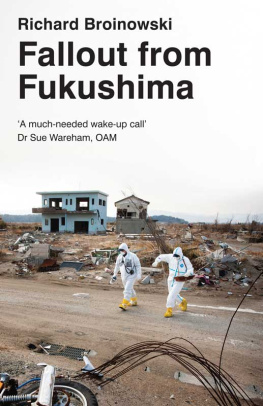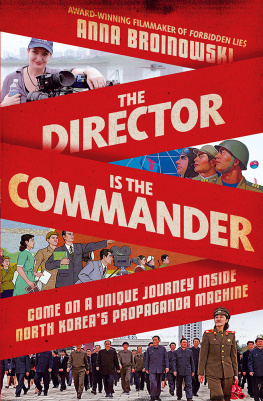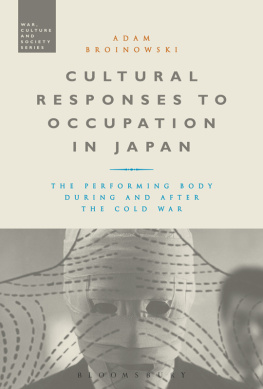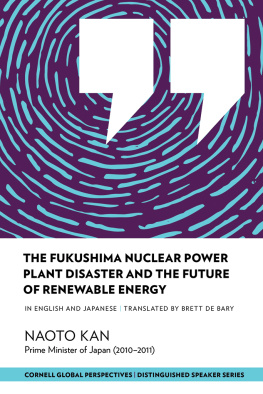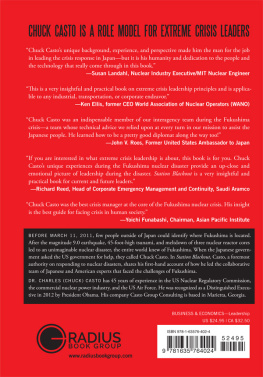
Scribe Publications
FALLOUT FROM FUKUSHIMA
Richard Broinowski is a former Australian diplomat. He was Australian ambassador to Vietnam, South Korea, Mexico, the Central American republics, and Cuba. He became general manager of Radio Australia in 1990 and, on his retirement in 1997, became an adjunct professor, first at the University of Canberra and then at the University of Sydney. Richard and his wife, Alison, live in Sydney. This is his fourth book.
To my grandchildren, Ava and Myshka.
May they and their descendants grow up in a nuclear-free world.
Scribe Publications Pty Ltd
1820 Edward St, Brunswick, Victoria, Australia 3056
Email: info@scribepub.com.au
First published by Scribe 2012
Copyright Richard Broinowski 2012
All rights reserved. Without limiting the rights under copyright reserved above, no part of this publication may be reproduced, stored in or introduced into a retrieval system, or transmitted, in any form or by any means (electronic, mechanical, photocopying, recording or otherwise) without the prior written permission of the publishers of this book.
Maps drawn by Bruce Godden
National Library of Australia
Cataloguing-in-Publication data
Broinowski, Richard.
Fallout from Fukushima.
9781921942938 (e-book.)
1. Fukushima Nuclear Disaster, Japan, 2011. 2. Thoku Earthquake and Tsunami, Japan, 2011. 3. Nuclear power plantsAccidentsJapanFukushima-ken. 4. Nuclear reactor accidentsJapanFukushima-ken. 5. Nuclear energyJapanSafety measures. 6. Nuclear power plantsRisk assessmentJapan. 7. Nuclear energyGovernment policyJapan. 8. Radioactive pollutionJapanFukushima-ken. 9. Tsunami damageJapanFukushima-ken. 10. JapanPolitics and government21st century. 11. Thoku Region (Japan)Social conditions21st century.
363.17990952117
www.scribepublications.com.au
Contents
In the misty realms out past Fog Facts there are things that Must Be So But Cant Be Stated. They have happened as understandings, as nods and winks. If at some point they had to be made explicit, none of the parties will say that such agreements occurred because they are, by nature, covert and are frequently crimes, and must be protected by silence.
Larry Beinhart, The Librarian
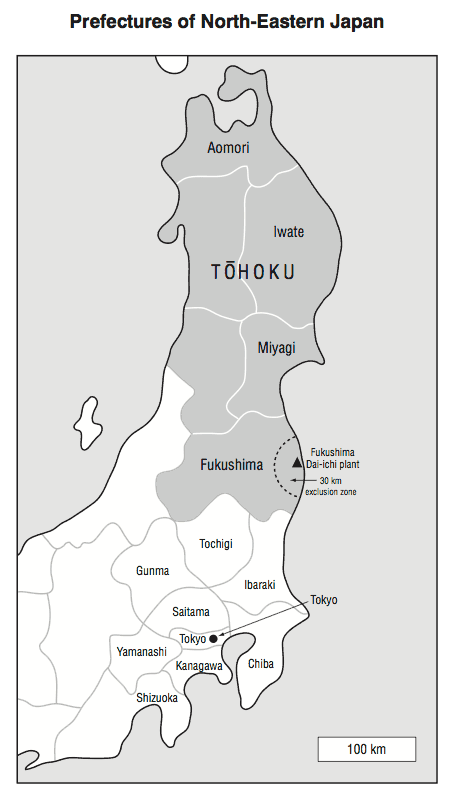

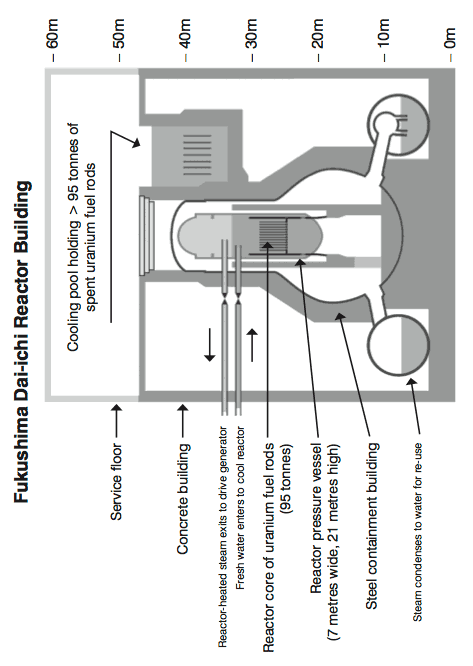
Introduction
IN OCTOBER 2010 , President Barack Obama hosted a conference in Washington, DC of leaders in the international nuclear community. The conference was a reaction to the attacks on the World Trade Centre in New York and the Pentagon in Washington on 11 September 2001. It focused mainly on nuclear terrorism: how to protect civil nuclear reactors from airborne or ground attacks by terrorists, and how to safeguard nuclear materials from being stolen by terrorists for use in nuclear weapons or dirty bombs.
By March 2012, the worlds nuclear worries had changed. Another international nuclear-safety conference was held in Seoul, South Korea. It continued to focus on safeguarding nuclear materials from terrorists, but the subtext was about the nuclear catastrophe a year earlier at Fukushima in Japan. The stakeholders who were in Washington reappeared in Seoul representatives of governments, reactor manufacturers, nuclear regulators, mining interests, electricity utilities, United Nations bodies such as the International Atomic Energy Agency, and, at the margins, public interest groups, a small percentage of which were anti-nuclear. Sous sherpas in Helsinki and New Delhi had been preparing for the Seoul conference for months, massaging eight key points into a draft communiqu. According to conference publicists, the goal was now to formulate responsibilities, commitments, and procedures to safeguard reactors from accidents as well as terrorists. These measures had to be politically acceptable to state leaders, as well as being consistent with national and international regulations.
Political acceptability was partly achieved by the exclusion from these preparations and from the conference itself of any serious attempt to examine whether nuclear power was simply too dangerous to continue to generate electricity. With 21 nuclear-power reactors of its own providing 40 per cent of the countrys electricity, five more reactors under construction, and a competitive nuclear-export industry, South Korea was hardly likely to contemplate such a question. Indeed, the motive of the organisers was to reinforce the message that nuclear power was already safe, and becoming safer as new generations of reactors came online. They sought, in effect, to perpetuate nuclear business as usual.
This book takes a different and more sceptical approach towards nuclear technology. It describes in detail what occurred at the Fukushima Dai-ichi nuclear complex when an earthquake and tidal wave struck the Thoku coast in north-east Honshu on 11 March 2011. It rebuts the contention of pro-nuclear advocates that the reactors were able to withstand major earthquakes, only to be undone by a completely unforeseen tsunami. It examines the lives of many people that were forever changed by the disaster, and the devastating long-term effects of radiation on the countryside. It analyses the broader political and economic effects of the reactor meltdowns in Japan, and how, for the first time in postwar history, the Japanese people are becoming significantly resistant to government and big business telling them that nuclear power is good for them. What it does not and cannot do is accurately predict the number of deaths that will occur from radiation at Fukushima. A disingenuous assertion of the nuclear industry is that, as at Windscale or Three Mile Island, no deaths occurred as a result of radiation at Fukushima. But they did and they will, only not yet, because radiation-induced cancers usually take a long time to develop.
This book also traces the history of research into ionising radiation, beginning with Marie Skodowska-Curies discovery of radium little realising that the element was destroying cells in her body. It shows how, even when such knowledge was available, nuclear scientists and government officials frequently denied the capacity of ionising radiation to maim and kill and cause cancer and genetic mutations denials which surrounded the first atomic-bomb test at Alamogordo in New Mexico in 1945, the atomic bombings of Hiroshima and Nagasaki the same year, the hydrogen-bomb tests at Bikini Atoll in the Pacific in 1954, British tests at Emu Field and Maralinga in central Australia in the 1950s, and the United States atom- and hydrogen-bomb factory at Hanford in Washington state from 1948 to the 1960s. In the wake of nuclear accidents at Kyshtym and Windscale in 1957, Three Mile Island in 1979, and Chernobyl in 1986, the denials continued. Authorities are now doing their best to downplay the carcinogenic and mutagenic effects of radiation leaks into the Japanese countryside from the Fukushima catastrophe in 2011.
The book looks, as well, at the international ramifications of Fukushima how some countries, such as Germany, Austria, Belgium, Switzerland, Italy, Kuwait, and Indonesia, are turning away from nuclear power, and towards renewable energy as a future sustainable source of base-load electricity; how others, such as South Korea, Russia, Belarus, Britain, France, India, China, and Vietnam, remain committed to nuclear technology and the expansion of their nuclear-power-generating reactor fleets, although some of them are growing cautious in the face of increasing public concern.
Next page
